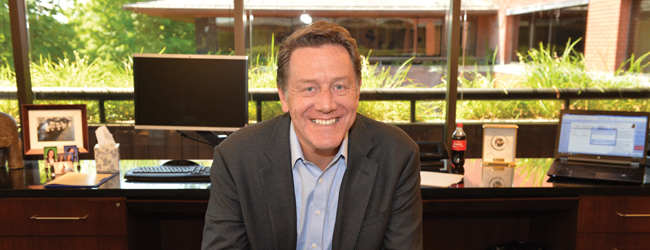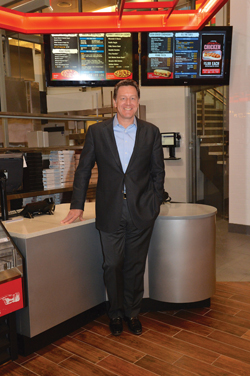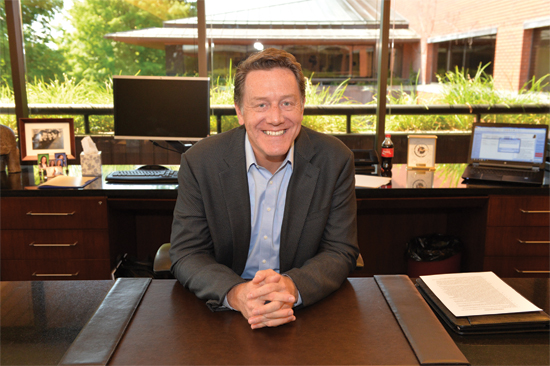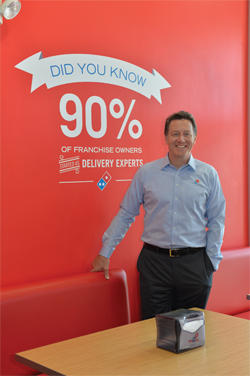
A Passion for Pizza and People
 Tell us about your career with Domino’s, when it began and when you took over as CEO.
Tell us about your career with Domino’s, when it began and when you took over as CEO.
I’ve been here seventeen years. I joined in 1997 and became CEO in early 2010.
What was your educational background before you entered the business world?
I completed my undergraduate at the University of Michigan, here in Ann Arbor, with a degree in Economics. I, then, earned my MBA at the University of Chicago.
When you took over as CEO, you must have done a self-assessment of the business. What were the strengths you saw at Domino’s? What were the areas you wanted to see improve?
I’d already worked here for thirteen years, so that it wasn’t like I needed to separately step back, when I became CEO. I already knew the business well, knew where we were and how we were doing. We were going through a re-launch of the brand, right as I was becoming CEO. We clearly knew that we needed to improve the perceptions of the quality of the pizza with our customers, and we were doing that as I was becoming CEO. The other big area that has played a part in the growth of the brand and the business the last few years has been our use of technology. That’s been a really big change for us over the last few years.
How important do you think it is for a business, big or small, to take a candid look at itself so that it becomes better?
There’s no question you have to be doing that on an ongoing basis. The most important part of that is you just need to take the discipline of stepping back from the business, every once in a while. It’s hard when you’re down in the business; you’re executing day-in and day-out.
You have to find the time when you can step back from the business and say, “How are we doing? Longer term, are we heading the direction that we need to be going as an organization? Are we becoming better every day?” I have different ways that I do that to make sure that I’m doing it, personally, and as a team, for the business.
Recently, I read about a consumer survey involving all the fast-food chains, and Domino’s was in the top three of all the surveyed brands. What were the major reasons why consumers rate you among the best?
It’s really a combination of things. We have always been known as the ‘delivery people,’ so that we’re about service. That was the basis of the brand, as we grew. We do very well with consumers from a service, convenience standpoint. We do well on value. The new part, for us, is that consumers are giving us credit for offering great-tasting pizza. We didn’t previously see this in ratings. As food quality and taste scores improve, our overall rankings on those things have also improved.
Do you have any systems in place to determine how your customers view Domino’s? And how important is feedback for any business?
Absolutely. We’re getting that constantly, so that we have ongoing consumer surveys. We’re looking at all the key attributes around the business: how we’re doing on taste and quality and service; diving into diagnostic things around how our people are treating the customer; all those sort of things.
We have an 800 number where we’re taking both praise and complaints. We track those to look at whether there are any trends or where we’re having consistent issues.
The new one is Social Media. Over the course of the last five, six years, as Social Media has grown, it’s become a very powerful place to see how your customers are thinking about the brand and the business. We’re monitoring that; we’re responding to issues that customers might have with the brand. That’s an important part, to be monitoring the strength of the brand as well as the business.

That helps you improve?
Absolutely.
What are the core business principals that drive you and your management team, which can help guide our small business readers?
There are a number of things. You start with some of the basics. You have to have the right people in place. We have about 250,000 people who put on a Domino’s Pizza uniform, around the world, every night. So getting that right—figuring out how you find great people who want to take care of customers—that’s a first core part of the brand that I think most people know.
One of the things that we do differently from a lot of people in the restaurant industry (which tends to be a very promotional category—with a lot of coupons, a lot of price promotion, new products—just to obtain attention from customers), is to pull away, very purposefully, in the last few years, from some of that activity and to make certain that the things that we’re doing (and that we’re advertising) are things that are going to, long-term, improve our customers experience with the brand. Not just something that’s going to spike sales this month, but ask if what are we’re doing is truly improving, long-term, their experience with us? Focusing on that goal has built a lot of momentum in our business.
The pizza business is extremely competitive. Domino’s just recently announced a new ordering app for customers that is on the cutting edge of technology, where you can order a pizza with your favorite toppings with an interactive voice application that can take your order. Tell us about this new innovation for consumers and how competition factored into its development.
Competition wasn’t that big a part of it. The real key is looking at our consumers and where we think that our customers are going to be in five or ten years. As we’re envisioning technology and how technology is evolving, it’s clear that we’re going to look back in ten, or twenty years, at all of us sitting with our phones, thumbing through emails and texts, and we’ll say, “I can’t believe we did that!” It’s a pretty lousy way to interface with technology and to access technology.
We’re going to see voice become the main way that you access technology. You’re going to have a microphone, somewhere, wired in every room in your house, and you’re simply going to say what you want.
Think about your clicker with your television; it makes no sense. What you want to do is walk into your family room and say, “I want to watch the World Cup Final,” and it’ll pop up on your screen. All of that is doable, today. As we see that moving, we want to jump in early. We’re the first to be using voice for commercial order-taking purposes. It’s a more natural way for customers to interact with us, and we’re excited about it.
When I used the voice app for the first time, I was impressed with how intuitively that it was designed. When the app asked me if I wanted to order anything else, I was surprised that it would allow me to go back to previous sections of the ordering process to add something I forgot, just like a real person taking my order would allow me to do. In this day and age, how important is it for businesses to stay ahead of the technology curve, like you have accomplished with the pizza ordering voice app, which interacts with you while taking your order?
I think it’s critical. We’re now quickly approaching half of our business being over digital channels. Right now, we’re around 45 percent. Looking at that, we have to make it easy and convenient for our customers. It’s how they want to access the brand, through technology. As a big company with scale, we can invest in something like this. That’s harder for a smaller business to do, but for us, it’s the strength of being big. We can make an investment like that and get it right—make it intuitive and easy for customers to access the brand. And then our franchisees are receiving the value of that innovation.
How are digital and voice-ordering systems you’ve put in place driving the growth of Domino’s today?
Digital has been a very big part of our growth over the course of the last five years. It’s absolutely going to continue to be. Voice is very early, and we’re still in a BETA form. We’re still making it better and learning as we go. Short-term, it isn’t going to be a huge driver of the business; longer-term, we think it’s going to be the next generation of technology, and we wanted to be there early.
You’ve made it so easy to order a pizza that, recently, a Frontier pilot ordered fifty Domino’s pizzas from the cockpit of his plane for his stranded passengers after the plane was diverted from Denver to Cheyenne, Wyoming. You must have been happy to see all those Domino’s pizza boxes being passed around the cabin on the plane. What was your reaction when this story went viral?
We were thrilled, clearly. That’s about that pilot giving great service to his people. Our team did a terrific job. They scrambled (it was coming in late), they made great pizzas, delivered them there quickly. The big lesson in it was the empowerment that the employees have at Frontier to provide customer satisfaction. This pilot said, “Look, I’ve got a grumpy group of people: my passengers, our customers,” and he came up with a terrific solution. Happily, we were top-of-mind for him; so that he’s our hero, now.
They got all those pizzas past TSA, too.
Exactly.
 One of the reasons that franchisees are extremely successful as a business model is that, in addition to the brand, the franchisor creates business systems for small business owners to use in the management of the business. Why are business systems so necessary in helping your franchisees be successful?
One of the reasons that franchisees are extremely successful as a business model is that, in addition to the brand, the franchisor creates business systems for small business owners to use in the management of the business. Why are business systems so necessary in helping your franchisees be successful?
You’ve got to have certain basics in place: be able to monitor how your business is doing, so that you understand where you are from a revenue standpoint, cost standpoint, on an ongoing basis. As a franchisor, this is something that we’re able to provide. We have a common POS system from which the data comes out of the back. We repackage it up for our franchisees and the store managers, so that they can see how they’re doing. For us, now, it’s actually real time. It’s not even last week or yesterday. I can pull up on my phone, right now, how we’re doing so far, today. Our franchisees are able to make adjustments. If they’re particularly busy, they can call in another driver, because they can see it’s going to continue to build. They need to have the staff to handle it. It’s critically important.
As CEO of a large corporation, what advice would you give small business owners, who are not part of a franchise, about the necessity to develop systems in their business to control costs?
They clearly have to do it. It’s a critical part of the business. Most people don’t start their own business, because they want to control costs. They’re passionate about the product that they’re selling, or whatever it is that they’re doing, to drive and grow their business. It’s those disciplines that you’ve got behind it that are, ultimately, going to make you successful. That’s usually not where their passion is, but it’s a part of the business that you have to give attention. Otherwise, you’re not going to have a sustainable, profitable business.
What advice can you give small business owners about the need to manage their cash position and maintain a positive cash flow?
That it’s fundamental to the business and the success of the business. Again, we put in place systems for our franchisees, so that they’re able to look at that, they’re able to see how they’re doing. We try, very hard, to give them a sense of where they’re going, to help them see need for investment into the future. We’ll go through a planning process with them: do they want to build more stores? Do they want to buy stores? We help them build that into their cash flow outlook.
Just as importantly, even if they’re not planning on growing, by adding stores, we’re trying to give them a time horizon. For instance, we’re re-imaging all of our stores, right now. We were telling them a year before we even announced it, telling them, “Now it’s time; you have to have it done by ‘X’ time.” A year before that we were saying, “You know we’re looking at this; you should be thinking about this. You’re wondering… You’ve gotten questions: are we going to require this at some point? And the answer is: yes. We’re going to do this, and you’ve got to start building that into your cash flow expectations. As you’re having discussions with banks, you need to be thinking about the fact that you’ve got a fifty thousand dollar expense for re-imaging coming up, per store, so that you can build that knowledge into your cash flow projection.”
One of the things that have impressed me about Domino’s is that 90 percent of your franchisees started at Domino’s as a driver, or as a store employee making pizzas. What this shows to me is that the systems, which you have in place are so strong that you can teach employees, without a background in business, how to be successful business owners. What’s the magic behind the systems that you have developed for your franchisees to become successful business owners, and is there a lesson for other business owners about the importance of building strong systems as part of their business foundation?
It really goes very directly back to what we were talking about before. We have these franchisees who have come up through the system; they’re passionate about pizza. They started delivering pizza, or answering phones, or making pizzas in our stores. They like it, they love the business, they want to be involved; but these are not people who were business owners, before. As a franchisee in a system like Domino’s, we’re giving them that framework. We’re bringing them in, we’re training them and we’re teaching them how to think about the business from that perspective. An independent entrepreneur has to find a way to access that type of education on their own and has to put those systems (and the rigor and discipline around it) into place, so that they’re going to be successful.
Looking back to when you received your MBA and today as CEO, what advice can you give small business owners about the importance of developing the business and the financial reports needed to run a business on good financial information?
The answer is that they either have to build those skills themselves, somehow, or they need to find a way to bring somebody in who’s going to be able to do it for them. It’s bringing in somebody from the outside, or it’s hiring the person who is passionate about that aspect. Again, I don’t think that most people open their business because they’re passionate about the systems that they’re going to put in place in the background. But if they don’t do it, they’re going to fail.
One of the problems that many small business owners have is that they spend most of their time working in the business rather than on the business. As CEO, you’re not dishing out pizzas to customers; so what advice can you give to small business owners about the importance of making that transition from working in the business to working on the business, to become the master strategist of the enterprise?
The key is simply having the discipline of stepping back from the business. I do it, often, when I’m flying. We have business all over the world. When I’m on airplanes, it’s when I do a lot of my thinking. It’s quiet time, there’s nothing else to do. I’m not answering emails, I’m not taking phone calls. It’s a time when I can sit and think about the business. I’ll bring information with me that I want to be reviewing, while I’m on the plane.
And then, we’ll go through an exercise. Every year, I take my team offsite for three or four days. We pick specific big issues that we think that we need to be working on and that we need to be getting better at as an organization. The key is: you’re going to be in the business most of the time, but, you need to create a discipline process for yourself, in which you pull yourself out, every once in a while, and think about the core issues facing your business. Then, you strategize how you’re going to address them.
To make good decisions, you have to have good information. What are some of the information reports, which help you make better decisions? And what advice can you give small business owners on the importance of creating good internal systems for capturing the information required to make good business decisions?
That can cover a lot of territory. The first thing I do, every day, when I come in is open up my computer. I’m looking at the numbers from the previous day, looking at trends both regionally, within the U.S., as well as looking around the world at how we’re doing and how the business is moving. That’s very short-term and tactical, but I have other reports that I’m looking at on a weekly basis, or on a monthly basis, around the business. That’s all of the financial and sales data. Separately, I’m looking at customers and how customers are feeling about us and the trends spotted there. That’s critical, as well, because that’s the long-term health of the business: how does your source of revenue feel about the business? That’s, ultimately, more important than anything else.
To drive a car, you need gauges to tell how fast you’re going and how the engine is operating. That type of dashboard for businesses is found in the reports, which give you a quick read on the critical variables in the business. Do you have a system in place to tell you what you need to know about Domino’s when you walk in the door on Monday morning? And how important is that for you as CEO?
I do, every morning. Every morning, I’m opening up my dashboard and looking at how we’re doing as an organization. I spend fifteen minutes, to half an hour, with that every morning, over my cup of coffee, to see how we’re doing. That’s a critical part of what we do.
Every business goes through challenges. A couple of years ago, Domino’s ran into some consumer problems about the quality of the pizzas, and you confronted them with both candor and a personal resolve to fix them. Tell us about your approach. How you have approached these challenges as CEO?
The key insight for us has been that if you look back at business twenty or thirty years ago, companies, big brands, could buy hundreds of millions of dollars of advertising. It was a one-way conversation with customers. We would tell you how to think about Domino’s pizza. Proctor and Gamble would tell you how to think about their brands. That dynamic has changed rather dramatically. We think about advertising and media and marketing today as a way of informing the conversation that’s happening, out there, with our customers.
The reason we approach it this way is, if you look at every survey done today, people will tell you they don’t trust big brands, they don’t trust big businesses, they don’t trust government, they don’t trust big institutions, in general. They trust family and friends. Increasingly, family and friends are communicating with social media; and that’s, ultimately, where the brand lives in that conversation that they’re having. Our media buys and our advertising are informing that conversation, but the power in the relationship is there. It’s in the conversation that’s happening about the brands amongst family and friends. Being informed by, reacting to, listening to and understanding that dynamic—that’s the key thing in the brand. It’s how we think about how we communicate, today.
What are your personal values and principles which drive you, every day, as CEO of Domino’s?
What really motivates me—I’m a competitive guy, I want our business to be doing well. But, what really motivates me is how we have this system that we’ve developed, taking people who are passionate about this business, who might not have been owners or operators of their own business, otherwise, and we’re helping them to succeed. Having these people, who are now friends of mine, grow their businesses and do well with their business, that’s what really motivates me. Having conversations with people, and they’re talking about how well they’re doing and how excited they are and how it’s impacting their family and what they’re able to do—that’s exciting stuff.

